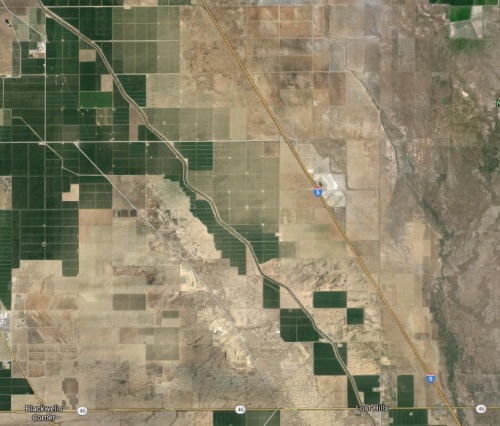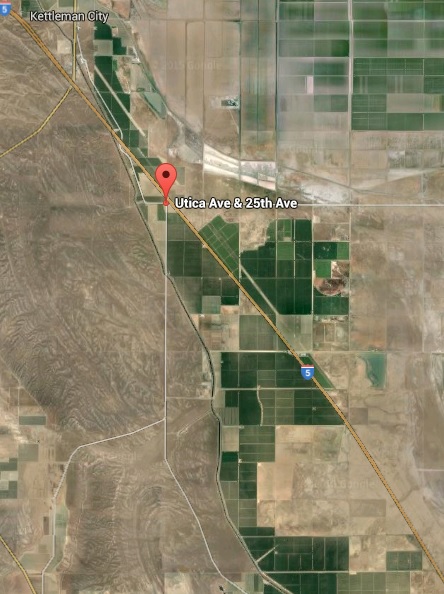As groundwater sustainability agencies have to bring irrigated acreage in line with the sustainable yield of the groundwater basin, they will be retiring irrigated lands (Dr. Burt: 1-1.5 million acres; Dr. Lund: up to 2 million acres). I say 3 million acres, because so far everything we’ve predicted for climate change has been an underestimate.)
I have two top priorities for the Central Valley’s farmland.
- Preserving about 5 million acres of the best ag land for growing food for humans, mostly Californians. I don’t worry too much about this goal, because we have about 9 million acres of ag land now, so we could lose quite a bit before I get concerned.
- Minimizing the human misery from the transitions brought by climate change. Assuming that retiring farmland sucks for the farmers whose land is retired, and sucks for their communities as people leave farms, that means choosing to retire lands that support the fewest people and communities. It turns out there are entire water districts where not one single person lives. Not one person would lose their way of life if these districts closed.
27,000 irrigated acres, approx. 80,000AF/year
Boundary map here. Centered satellite map here. (Click to expand and verify. Not one house, no towns.)

32,000 irrigated acres, approx. 90,000AF/year
Boundary map here. Centered satellite map here (no houses, no towns).

Dudley Ridge Water District (no website):
17,000 irrigated acres, approx. 34,000AF/year
Boundary map here, page 50. Centered satellite map here.

What is that green, up in the corner? I think it is Westlake Farms. Sixty-thousand acres, give or take, depending on whether their neighbors have been paying attention. That means about 180,000 AF/y.

The owners of Westlake Farms do live on the farm, so if that acreage were retired, they would feel misery and so might their 11-50 employees. But that’s still not a whole lot of people.
There is a lot of acreage like this. Compared to the southwest corner of the valley, even the notorious Westlands Water District is relatively populated. For contrast, look to the east in the Friant. Those are towns and many, many farms. Were those acres retired, many people would feel miserable. My second criteria for retiring ag lands (minimize human misery) leads to preferentially retiring lands in the western valley. Responsive local groundwater sustainability agencies should think carefully about their criteria for land retirement. Geology and hydrology are only two factors. The way their constituents want to live going into the next few decades should matter far more.

A CONTRARY TAKE:
I would listen to an argument that minimizing human misery might mean evacuating the San Joaquin Valley. With the higher day and night temperatures, the upswing in air pollutants from heat, the decrease in breeze and fogs, maybe the SJV will be an overheated hellscape by the end of the century. In that case, minimizing human misery could mean huge agribusiness with minimal human labor. In that case, the districts above are the ideal and should be favored by GSA policies.

I understand that those districts may not have gotten any state water this year. But if their trees are alive, they put about 2-3af/acre-year on those trees. It came from somewhere and is a load on the system that could be either left underground, left in rivers or used in the southeast Valley.
Nitpicking here- plenty of farmers don’t live on their land and yet rely on it as a source of livelihood (Eastern CO and the corporate-welfare CV being somewhat different here, admittedly), and surely all the farm operations with no houses on them employ regular workers, especially if they are in permanent or other labor-intensive crops. They aren’t sitting there getting irrigated by themselves.
I am nigh-certain that the owners of these lands could console themselves by swimming in pools filled with hundreds.
You are right, of course, that laborers would be hurt. But these orchards take less labor than truck crops.
Habitation does not seem like a relevant criterion. California ag should trend toward more mechanization, and away from poorly paid labor; fewer, more skillful jobs with higher pay. Many small communities in the San Joaquin do not bring in enough income to maintain healthful water and sewage systems, and State support of those systems is merely a subsidy to big ag, as unemployment insurance is a subsidy to California ag in general.
Stopping farming on the large acreages of SW Kern County reminds me of Swift’s “Modest Proposal”. The climate and soils are good, at least presently, and crops grow well. Infiltration and drainage of all farm land throughout the State is non-uniform. That is the nature of soil. A more measured approach to reducing water consumption is to cease farming the most non-uniform portions of fields state wide. Restricting irrigation to, say, the most uniform eighty to ninety percent of existing fields (or some smaller percentage if climate change requires) would greatly improve water use efficiency, and achieve the return of aquifers to sustainability without greatly impacting individual communities.
An enlightening and well though out analysis. I couldn’t agree more. Thank you.
Excellent BSiegfried, yes sir..yet the question of what constitutes True Water management sustainability to me remains unanswered. In analyzing what that might be I suggest we broaden our assessment. We need to factor in the Paleo Climatology of the West. Fact, the previous century was the wettest in the last 1000 yrs. The West is primarily a desert. That’s been our history for several hundred thousand years..Long droughts of 50yrs, 100yrs, even 300yrs. cycle through Our neighborhood more often than we previously thought. Thanks to better scientific research today we Must understand this and Must act accordingly. I mentioned it earlier, a 2015 study on weather in the Western U.S. by NASA, Columbia, and Colgate projects that by 2050 there will be an 80% probability of a 30+yr. drought in the West, at the current level of carbon dioxide emissions..Consider this, that study was based on Current levels of carbon emissions. CEs are not subsiding. The global economy continues to increase carbon emissions.. Yes the G20 appear more serious after Paris but CEs continue to increase annually. Being realistic about the actuality of CEs that will be achieved in the next few years 2050 could become 2040 for that super drought to ensue.The most draconian measures in water management will fall Far to short in such a drought of course.
Consequently, there is no point in Costly stop gap actions to prolong the inevitable.
What’s to be done now that we have developed so much desert with waaay to many human beings in it..? A few possibilities, I welcome any thoughts on these..
1) find incentives to accelerate the migration of farming to the eastern U.S. where the water is. Its been happening for approx. 2 decades now so let’s help it along.
2) demand that our representatives stop all issuance of water well permits in the entire state. The CA aquifer system is our emergency charge card for future droughts. We have to pay down this balance (stop it depletion) so it’s available when we really need it.
3) create financial incentives to aggressively recharge the portions of the CA aquifer system that are currently depleted.( Implement Bob Siegfrieds excelent suggestions for example, Vlads too)
4) all water wells should immediately be registered, metered and regulated.. Big fines for any abusers.
5) stop fracking in CA now. It’s Way too polluting…Of our precious -Endangered already- water resources.
6) create financial disincentives for all water intensive crops in the state.
7) forget about that cost prohibitive Canal, Jerry. It’s nothing but stop gap.
8) create financial incentives for farmers implementing irrigation efficiencies
I know Some of these are strong measures but if ever an ounce of prevention were worth a pound of cure. This is it…The Super drought is very definitely in the pipeline..of our future. The only question is when will it arrive??
I should emphasize I am by no means a gloom and doomer. I believe there are solutions, innovations, effiencies to be gained, and wonderful creative answers yet unthought of that will come forward regarding CA water management…